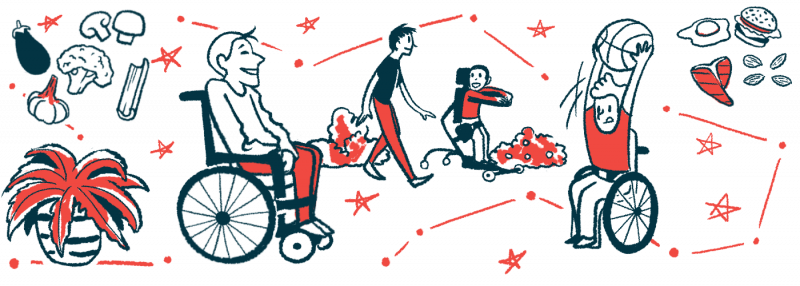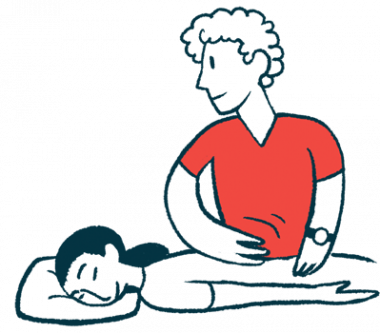
Living Well With SMA Spinal muscular atrophy (SMA) is a rare genetic condition characterized by progressive muscle weakness and atrophy, mainly affecting motor function, but often also causing speaking, swallowing, and breathing problems, along with other symptoms. SMA affects each person differently, depending on the type and severity of the disease, so living well with SMA will mean something different to every patient. But there are many strategies patients and caregivers can use to potentially overcome some of the day-to-day obstacles associated with the disease and maintain their physical, mental, and emotional health to the fullest extent possible. Having an experienced, multidisciplinary healthcare team that manages treatment plans and helps improve quality of life with recommendations for proper nutrition and exercise, as well as support for emotional and mental health, also can go a long way toward ensuring a patient with SMA can live their best life. Treating this disease involves more than just managing the symptoms. Patients and caregivers must find a balance between life and life with SMA. Navigating the world as a disabled person has its own set of differences and solutions. |
|---|
 Did You Know? SMA can have a profound effect on the quality of life of individuals with the disease, and much research has focused on improving and maintaining the best quality of life for people with SMA. A 2021 questionnaire-based study, which examined emotional coping strategies used by families with children or adolescents with SMA, found that mothers were interested in finding solutions that may improve the quality of life of their children with SMA and their families. |
|---|
“It’s almost impossible to represent the intricacies of SMA, the tangle of contradictions that make up life with rare disease.Because it’s hard. It’s exhausting. It’s a treadmill of obstacles, from accessible transportation to medication administration. … SMA is unforgiving. Punishing. It takes and takes and takes.But it also gives. SMA pushes me to be a better person — to take care of myself and the people I love. SMA breaks me, but it always puts me back together, in ways I would never have expected. SMA forces me to be grateful. To say thank you, and please, and would you mind not boring holes into my head with your eyes?SMA is one big stretch. Often uncomfortable, occasionally rewarding, always an adventure.”— Brianna Albers, columnist, “The Wolf Finally Frees Itself” |
|---|


Overall Wellness
Living with SMA involves more than just doctor appointments and prescribed treatments. It also includes a safe and appropriate exercise plan, proper nutrition, and therapeutic options to address the mental and emotional health of patients. A dedicated healthcare team can assist a patient with everyday needs or allow them to live more independently.
Aside from simply managing symptoms, patients can achieve a better quality of life through wellness efforts. This involves daily practices that can contribute to leading a healthier, happier, and overall better life. Most treatments for SMA may focus on surviving, but wellness enhances a patient’s life so that they are thriving — not just physically but mentally and socially as well.
Wellness efforts can include connecting socially with like-minded communities, exercising regularly, good nutrition, a healthy sleep schedule, and practicing mindfulness. These activities can help reduce stress and improve the overall quality of a patient’s life.

 Did You Know? Many treatments recently approved for SMA are aimed almost exclusively at children, and there still is not a great understanding of how SMA affects adults in day-to-day life and the best strategies to ease their disease burden. According to a 2020 review study, a better understanding of the needs of adults with SMA, best ensuring their mental, social, and physical well-being, is necessary to guide future research, care recommendations, and policy decisions. |
|---|
“Throughout this medical journey of mine, I’ve focused on my body through a holistic lens. Medications and treatments are staples in my SMA toolbox, but staying on top of small, everyday measures that promote wellness and healing is a way for me to nurture my body in essential ways.The regimen of my days is infused with natural ingredients. I fortify my body with fruitful choices in nutrition and hydration. I pay close attention to what foods my body is more or less receptive to. I engage in meditation to mellow my anxieties. My caregivers help me with daily stretching, massage, and exercise. It’s an attempt at self-love that is rarely seamless and never perfect.I sing and dance. I inhale twinkle and exhale laughter.”— Katie Napiwocki, columnist, “A Wildflower in the Wheelderness” |
|---|
 Did You Know? Fatigue is a common and disabling complaint of many patients with neuromuscular diseases, including those with SMA. A 2019 study suggested that the sense of fatigue perceived by patients with SMA does not correlate with their physical tendency to get tired, their motor function, or quality of life. This feeling of being tired, or perceived fatigue, can be independent of the patient’s physical performance and depend on many other factors including those of a psychological nature. |
|---|
“Living with SMA, fatigue and muscle weakness has always been my main problem, but lately, it has taken a lead role in my life. I should be used to it at this point, especially considering the time of year. The inner workings of my body have always been freakishly in tune with the environment, and every year when daylight saving time hits in November, I become out of sorts for weeks. My internal clock stops working. My body wants to sleep by day and party all night. Meanwhile, my brain tries fighting these feelings by training my body to adapt to its ‘new’ environment. And let’s just say it’s a perfect storm for disaster to strike.”— Alyssa Silva, columnist, “Life, One Cup at a Time” |
|---|


Exercise
One therapeutic option that may be recommended to improve the quality of life of SMA patients is exercise. Patients need to work with a physical or occupational therapist to establish a safe exercise program to ensure maximum mobility. In general, a likely exercise program will be tailored to the person’s abilities and will involve stretching to improve mobility and range of motion, aerobic exercise to build lung capacity and strength, and resistance training to build muscle strength.
People with SMA should try to engage in as many physical activities as they can without overexerting themselves. Physical activity will not only help keep patients as fit and healthy as possible, but also helps with psychological health and emotional well-being. Exercise or physiotherapy also can help ease muscle stiffness, improve circulation, and preserve joint flexibility.
Doctors advise that people with SMA do as much as they can, but to be careful not to overdo any kind of physical activity as becoming too tired is counterproductive. Some types of exercise that may be beneficial for SMA patients are highlighted below.

 Did You Know? In an exercise-based study, it was discovered that cell energy production may play a key role in SMA. Patients with SMA had poorer oxygen uptake in muscle cells and greater fatigue compared with healthy people. Scientists indicate that a better understanding of the mechanisms involved in oxygen uptake by muscle cells during exercise may lead to new treatment targets. |
|---|
“Developing an exercise routine that I can do independently is something of a milestone for me. Though I love getting in the pool every week, … my physical limitations resurface as soon as I’m back on land. Even with all the freedoms that my chair provides me, I still have limited mobility with my upper body. For better or worse though, life with SMA is full of surprises.For someone like me who’s lived with SMA my entire life, I value the little gains of physical independence. Anyone who reads my work knows that I proudly wear my disability stripes, and that I embrace the good and the bad aspects of this life. I don’t fantasize about magically transforming into an able-bodied person. I’m complete as I am.”— Kevin Schaefer, columnist, “Embracing My Inner Alien” |
|---|


Nutrition
Each person with SMA has a unique set of needs based on who they are and the severity of the disease. Diet is an important part of anyone’s life — more so for those with SMA. There must be a balance between digestible foods, weight gain, and vitamin consumption.
People with SMA may experience abdominal problems such as diarrhea, bloating, spitting up, vomiting after meals, bad breath, regurgitation, and abdominal distention. Some metabolic problems include fasting states, which begin about four to five hours after finishing a meal, as well as catabolism, where the body breaks down muscles to get energy due to the fasting state. This can lead to low sugar and unusual levels of fatty molecules in the blood.
Patients are encouraged to consult with their doctors and healthcare team to determine the right dietary needs to combat these issues. Some treatments are available to assist with gastrointestinal issues, such as acidophilus or lactobacillus.
GERD
One of the frequent gastrointestinal issues that patients with SMA deal with is GERD, the frequent flow of stomach acid and contents back up the windpipe. Common signs include vomiting after meals and chest or abdominal pain. GERD may lead to silent aspiration such as coughing or choking, which can raise a patient’s risk of pneumonia and respiratory distress.
Constipation
Due to the weakness in the muscles of the digestive system, constipation also is an issue for SMA patients. This can cause abdominal discomfort with distention and bloating. Patients are advised to drink plenty of fluids and increase their fiber intake.

 Did You Know? A 2018 study reported that patients with SMA types 2 and 3 are at risk of malnutrition, altered metabolic rates, and changes in body composition. The researchers suggested that individualized nutrition plans may correct body composition, decrease symptoms, and improve quality of life, especially with recent therapies that regulate metabolism. |
|---|
“In terms of what I recommend for other folks with SMA, there really is no standard diet. Some rely totally on feeding tubes and specialized diets, while others can eat a wide range of foods. The best thing to do is figure out works best for you, and talk with your primary physician.These days, I do eat out too much. … Still, I try to have a balance and eat home-cooked meals on most weeknights. I’m far from perfect, but just knowing that I’m no longer a stick of a human being who refused to eat anything unprocessed or full of sugar reminds me I’ve come a long way.”— Kevin Schaefer |
|---|


Mental Health
Mental and emotional health are greatly affected by chronic physical disorders such as SMA. The symptoms that cause motor problems and other aspects may reduce the quality of life for patients, which can then lead to anxiety, depression, and other psychological disorders.
SMA can be a difficult disease to manage and can very easily affect a person’s mood. While SMA can lead to depression, or even exacerbate a preexisting diagnosis, it is possible to moderate the symptoms of disorders such as major depressive disorder or dysthymia.
Being more social and participating in adapted sports has shown benefits for mental health. Positive social activities can relieve stress, while playing sports can improve self-esteem and lessen depression symptoms. This is in part due to the establishment of friendships and a good support network. Note that there isn’t a lot of published scientific research concerning people with physical disabilities and participation in sports, and most research to date has focused on its physical effects.
Anxiety and Depression
According to studies in adults with SMA, patients’ levels of anxiety and depression were significantly affected by the disease. These mental health issues may cause a lower interest in social activities, limit motivation, and impair cognitive function, which can further reduce quality of life.
Here are some tips on how to deal with depression:
Exercise: Evidence suggests that regular exercise can help manage symptoms of depression. Even a small amount of physical activity allows the body to release endorphins, endogenous cannabinoids, and other mood-enhancing neurotransmitters.
Physical Therapy: Physical therapy does more than improve motor skills and mobility; it can also reduce the feeling of being physically stranded, which causes the feeling of helplessness. Being able to move helps SMA patients feel in control and can reduce symptoms of depression.
Humor: A little humor can go a long way. Laughter in the face of a debilitating disease can broaden a patient’s perspective and combat negative feelings associated with anxiety and depression. Learning to embrace the absurdity, even if it does not seem funny in the moment, can have some surprising positive changes.
Being social: It is important to surround patients with people who understand what they are going through. Being social, whether online in community forums or in person with local friends and family, can help with feelings of loneliness and isolation.
Volunteering: Some patients struggle to find meaning in their disability or everyday life. A good way to contribute to society is to volunteer, and there are plenty of organizations for disabled people, such as the Muscular Dystrophy Association or the American Association of People with Disabilities.
Being supportive: Group therapy and other support groups can greatly impact the mental health of SMA patients. Online communities, such as social media, can connect people who experience the same issues or are similarly disabled. There are movements such as #CripTheVote and #DisabledAndCute on Twitter to show support for disabled individuals.

 Did You Know? In adults with SMA, studies have found that patients’ levels of anxiety and depression were significantly affected by the disease. The psychological health of school-age children and adolescents with SMA has not been fully explored; however, a 2021 questionnaire-based study in China suggested that school-age children and adolescents with SMA experience a high rate of anxiety and depression. |
|---|
“This journey of learning what it means to nourish my mind, along with my body, has been both messy and beautiful. I’ve learned so much about my inner self and what self-care looks like in terms of my well-being.I’ve reached some peaks and fallen into some valleys. I’ve been unkind to my mind but found grace and forgiveness. And I’ve made profound strides forward compared to the person I was a year ago.My progress hasn’t been linear. But the steady truth I’ve found on this journey is that my mind and body are more deeply connected than I originally thought. My mental well-being actually plays an important role in my physical health, and vice versa.”— Alyssa Silva |
|---|
 Did You Know? Regardless of the subtype, people with SMA experience moderate to severe disability that can weigh on their social lives. A 2018 study reported that the level of motor skills, as well as the intensity of depression and fatigue, influence the degree to which adults with SMA enjoy social and professional activities in daily life. |
|---|
“Mindfulness can be considered radical acceptance of the present moment. The underlying assumption of the overall theory is that in focusing on all the negative aspects of a given moment — physical discomfort, anxiety — we actually miss out on the moment itself. Life is inherently full of good things and bad things, and so it follows that in order to truly live, we must work to accept the good, the bad, and everything in between.”— Brianna Albers |
|---|



